| . 1 . 2 . 3 . >> |
| Author |
Message |
zorro
Member
|
# Posted: 5 Apr 2021 11:24am
Reply
Ok
Not sure what happened, but was at camp this weekend and my batteries froze - only 11 months old!!
Partly i think due to the water levels being a bit low - the elements were covered but the water was not at a maximum level i guess
So i need 8 new batteries urgently
I now lithium or even AGM's are the way to go - but right now i cant afford to pay that amount out
So looking to get 8 x Trojan T105's
Any idea of somewhere in the NY area i can get these?
Have called a couple of places but they seem to be OOS or not available
Thanks
Paul
|
|
Brettny
Member
|
# Posted: 5 Apr 2021 01:58pm
Reply
I actualy called the local golf cart place today. They laughed and said "good luck". They cant get any GC2 batteries of any brand and there getting them directly from the distributor. I may have a line on a US battery dealer.
|
|
zorro
Member
|
# Posted: 5 Apr 2021 02:06pm
Reply
Yep - had the same response from 2 or 3 places
Also had.............can get them but delivery is 4-6 weeks!!
Must be hiding the same place as all the ammo!!
|
|
FishHog
Member
|
# Posted: 5 Apr 2021 02:13pm
Reply
Charged batteries don’t freeze. A little low on water should not have resulted in frozen batteries. I would verify your system is charging and maintaining properly before adding 8 new batteries in and having a repeat
Can’t help you with supply but really suggest you troubleshoot thoroughly first
|
|
zorro
Member
|
# Posted: 5 Apr 2021 02:27pm
Reply
Totally agree with that
Batteries were totally discharged and only showing around 0.9V each
So it was very difficult to test much as the batteries were not being recognized at all as they were too low
There was ice inside the batteries, but did not crack
I have limited knowledge of this but have tried to troubleshoot as best as i could with a friend on his cell phone
From what i can see, power was coming from the panels to the inverter with no issues - checked with a voltage meter
we checked all fuses and breakers and seemed to be okay
The inverter seems to be working okay from what i could test and the charge controller did seem to be working
But that was only from a limited knowledge base
And i agree - dont want to spend $1500 on new batteries only to repeat the same issue next year
I have brought them all home and trying to restore them if possible
They have gone up, but seem to be "stuck" at around 5.4V, which may mean they are not recoverable
But i agree - seems like something went wrong somewhere - i know they were charged when i left in January and i know i switched off the inverter when i left...........so should not have been anything drawing on them over the winter months
Cleary something went wrong but i just d not know what
|
|
FishHog
Member
|
# Posted: 5 Apr 2021 02:43pm
Reply
I would doubt you can recover them if they were that low
Hope you figure it out
|
|
zorro
Member
|
# Posted: 5 Apr 2021 02:47pm
Reply
Yeah driving me crazy really
|
|
Brettny
Member
|
# Posted: 5 Apr 2021 03:58pm - Edited by: Brettny
Reply
I have group 31 marine batteries out in my car port, in charged since about october last year. There roughly 5yrs old and read 12.4v. about a month ago. They came out of my parents RV and there charge meter allowed them to drop to 11.9v.
I would say something went wrong but I also wouldnt trash them right now. Charge them with a transformer based charger not a smart charger. It may take a few weeks to really see if they are good.
Let us know what you find as I plan on leaving my GC2 batteries at the property all next winter.
|
|
|
razmichael
Member
|
# Posted: 5 Apr 2021 05:36pm
Reply
As noted, a charged battery will not freeze at normal winter temperatures (fully charged freeze is about -70C, at 80% it is around -55C). I leave mine at our cabin (Quebec, Canada) every winter. Even with panels getting snow covered there is enough to trickle charge through the winter despite also running a couple of motion sensors and cameras. inverter and everything else is disconnected. I'm assuming you do leave the Charge Controller connected so there must be something else that failed. Can't help with the supply issue sadly.
|
|
zorro
Member
|
# Posted: 5 Apr 2021 05:41pm
Reply
Thank guys
The whole system is only 18 month old
I actually replaced the Inverter last year as that failed!
Everything else is new
So that really only leaves the charge controller as the point of failure i guess?
All through the summer no issues, so I am assuming they were not getting charged at some point and when i thought they were left fully charged in January, if the CC had failed, then maybe not?
I need to see if someone can help me test this next time i am there and maybe see if the CC is the issue
But in any case, the batteries did freeze as there was ice inside
|
|
Nobadays
Member
|
# Posted: 5 Apr 2021 05:42pm
Reply
Zorro... sorry about your dilemma. If you can swing lithium now might be the time. Maybe start with a little less ah than you need and add when you can.... not as much of an issue adding to lithium banks.
Quoting: FishHog Charged batteries don’t freeze.
Last spring CenturyLink replaced 12 batteries, high dollar AGMs... in their switch box that serves our cabin area, off-grid so solar maintained. I stopped and asked them if it was periodic maintenance and what they were going to do with them. He told me they were only 6 months old but they had all failed, didn't know why. As he pulled one out it was clear, eh... the sides are bulged out, they had frozen. I said as much, he says, "Maybe but they have been hooked to solar all winter." They replaced them all. A neighbor told me a couple of weeks ago all the phones were out.... CenturyLink said the batteries had failed.... again.  
|
|
zorro
Member
|
# Posted: 5 Apr 2021 05:58pm
Reply
Yeah - Lithium would be ideal
Currently i have 8 x 6v @ 230Amps
I really only run LED lights, overhead fan and a small fridge - nothing else
Danby Fridge
https://amzn.to/3mxML9T
I am in the middle of building a new home, so timing is the issue and my wife would kill me if i went down the 8 x Lithium batteries
Essentially, I have maybe $1500 - $2000 to spend........maximum
So not sure i would be able to get much on the lithium front with that budget
|
|
Brettny
Member
|
# Posted: 5 Apr 2021 06:26pm
Reply
Remember that lithium isnt cold hardy either. Technically SLA is more cold hardy.
To really find out what happen you need to find a parasitic draw on the system. That could be a battery or the CC. What brand CC did you have? Did you just turn off the inverter or disconnect it?
|
|
zorro
Member
|
# Posted: 5 Apr 2021 06:38pm - Edited by: zorro
Reply
This is the CC here (SRNE ML4860, 60 Amp 12/24/36/48 Auto MPPT Digital Solar Charge Controller) ;
shorturl.at/wGTV2
In terms of the Inverter, this is it here - Samlex 1500 Pure Sine Wave
shorturl.at/joEMV
and we turned it off from the remote panel - from what i could tell, it went off as no lights would come on
So turned off - NOT disconnected
|
|
zorro
Member
|
# Posted: 5 Apr 2021 06:42pm
Reply
And i think that could be the issue - something is having a parasitic draw while i was away for 2-3 months
I have 2 friends nearby - really old systems, 6 batteries, tiny solar panels..................and this weekend, no issues whatsoever
Drives me crazy!
|
|
zorro
Member
|
# Posted: 5 Apr 2021 06:51pm - Edited by: zorro
Reply
My full system is as follows;
3 x 340W panels
8 x 6V @230Amp batteries (24 Volt)
1 x Samlex 1500 Purse Sine Wave Inverter
1 x MPPT 60A Charge Controller
1 x Battery back feed charger (runs from Generator)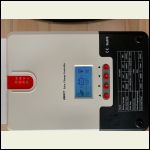
Charge Controller
| 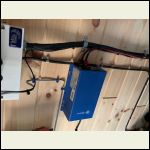
Battery Charger
| 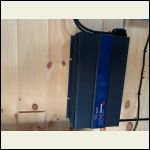
Samlex Inverter
| 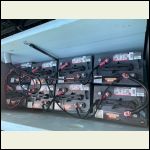
24v Battery bank
|
|
|
Nobadays
Member
|
# Posted: 5 Apr 2021 07:39pm
Reply
I see this 24v 200ah pre-built lithium on Amazon: HERE I don't know the quality of the cells but the BMS is reputable with cold temp disconnect. Just incase you do use the system in the winter... your post kind of indicates not- "2-3 months I was away."
Quoting: Brettny Remember that lithium isnt cold hardy either. Technically SLA is more cold hardy.
This is not a correct statement. Lithium can be left in a cold environment with little or no degradation for months, maybe years. The only downside of lithium if cold, below 0*C is that CHARGING at those temperatures will damage the cells. You can still discharge.
|
|
ICC
Member
|
# Posted: 5 Apr 2021 08:05pm - Edited by: ICC
Reply
Here's a quote from the manual of a Samlex pure sine wave inverter I have... different model but same family
"When the inverter is turned OFF using the optional Remote Control, some control circuitry in the inverter is still alive and will draw very low current. Therefore, to prevent any drain from the battery, switch OFF the inverter from the ON/OFF switch provided on the front panel of the inverter."
... so there was a constant drawdown over the months the inverter sat. Small but constant. I call that to be in standby mode, sorta like a TV remote control system. The TV is always drawing a little power as it sits there waiting for a signal from the remote control. I prefer using a circuit breaker to do an absolute shut off rather than even the on-off switch on the inverter.
The best practice with any inverter is to have an HD DC rated circuit breaker between the inverter and battery. It should be as close to the batteries as possible but not in the box with the batteries. Use that every time you leave the system and do not need to keep anything operating on AC power.
Did you notice, when you found the batteries frozen, whether or not the CC was connected to the battery bank? Was the CC display showing voltage? Even if the inverter was left on standby like you described if the CC was charging when the sun was shining the batteries should not have gone stone dead.
Nobaddays is absolutely correct on lithium batteries being able to sit there through a winter if left disconnected from any input or output. Leave them at a partial charge and when you return 6 months later they will still be at or only slightly below the voltage they were left. And do not charge the lithium when at or below freezing.
Being able to discharge will also warm the cells, possibly enough to allow charging. It is the cell temperature that matters not just the outside temperature. LiFePO4 are safe enough you could have them inside the cabin. Once the interior is all warmed up the cells may be warm enough to charge.
I pull the circuit breaker from the panels to the CC so all the input from the panels is disconnected. Then pull the breaker to the inverter and the other breaker that supplies low voltage DC loads. Then I forget about them until spring.
You might be lucky enough to still be able to use those GC-2's. One very good thing is that the cases never froze. We can't see just what internal damage there might be. Thaw them, charge them. Then see how the bank performs under use.
|
|
zorro
Member
|
# Posted: 5 Apr 2021 08:26pm - Edited by: zorro
Reply
Fantastic information there especially around the inverter - thank you
In terms of the CC - Here is a picture of what it looked like when I got there
But within about 15 minutes it then switched off entirely due to lack of power I think and then just showed “activateâ€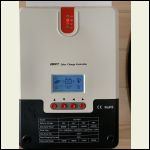
6A5A2346A7384FCAB.jpeg
| 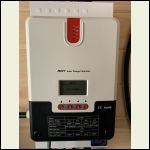
0FC0CEFA305C479FB.jpeg
|  |  |
|
|
zorro
Member
|
# Posted: 5 Apr 2021 08:30pm
Reply
Nobadays - thanks for the info on that battery - will have a look
|
|
gcrank1
Member
|
# Posted: 5 Apr 2021 08:35pm - Edited by: gcrank1
Reply
Since you are your own power company there you do need to know how to tell if the charge controller is pumping amps into the bat-bank. It is pretty much like any charger, a generator or your car alternator.
The 'battery' has a resting voltage and when a 'charger' is working it has to be putting more volts in than the battery reads resting (not being charged).
So, if the array is pumping amps into the cc you read on a multimeter (I dont just depend upon a cc readout) at the output buss of the cc AND at the bat-bank.
Now consider your bat-bank set up and how it is wired. If you dont have them series/parallel properly it can make downstream battery(s) to receive less and less charge. There are a bunch of good online references on how to properly wire multiple batteries. Typically one will have the battery feeds at opposite corners, same with inverter leads and all wires between batteries will be the same gauge and length.
Regarding 'phantom draw', the only failsafe 'switch' is a disconnect. The inverter may have been running some BUT, imo if the array was feeding the cc which charged the bat-bank it should have had well more than enough to feed the small phantom draw.
Now, if all that was so, and working well, what happens if one of the batteries in the series/parallel developed an open cell? It would be like throwing a disconnect switch in the middle of the bat-bank so no elec flow, no charge, no run, even though the array is pumping out amps and the cc doing its job and feeding to each end of the bat-bank.
Aint saying this IS what happened but I can see it as a possibility in your scenario.
Btw, if you determine the array and cc are good and even some of your batteries are salvageable (some may be well compromised and have lost a bunch of their cycle life but still be ok for a while with light loads) you may not need as much AH's of bat-bank if you wisely use the led lights and fan(s) and forego the fridge for now. Example: Right now, after our winter, Im down to only 1 of the original 4 12v x129ah agm bank, charging with 400w of array @ 24v through an mppt cc. It runs my led's and fan(s) fine as well as usb ports and other light duty stuff. Anything with a heavy, but short term load is for the little inv/gen.
If worse comes to worse and I cant get GC2's I will go with Marine Deep Cycle (Not Marine Starting) batteries to get over the hump. The 200ah LFP I want is a bit out of reach right now.
If you have to downsize your bat-bank consider if you need to adjust the cc or downsize the array also so you dont exceed the C rating for your remaining batteries.
Try charging each of those on a grid charger at no more than the recommended C rate, even the bad one(s) may read full charged but a surface charge can do that and still have no beans. But if one has failed internally it shouldnt charge up. Those that do you should give a 'load test' to only after fully charging. A handheld load tester will tell you right away if junk or not.
|
|
Brettny
Member
|
# Posted: 6 Apr 2021 06:05am
Reply
Quoting: Nobadays This is not a correct statement. Lithium can be left in a cold environment with little or no degradation for months, maybe years. The only downside of lithium if cold, below 0*C is that CHARGING at those temperatures will damage the cells. You can still discharge.
FLA can be used in all temps so it is true. Freezing of the battery came from a draw so lithium wouldnt have very happy about it either. You may just be making a $2,000 mistake and not a $800 one.
I looked up the stand by load for a samplex 1500w 12v inverter and its saying 0.75a...no battery is going to last months unless its huge.
|
|
zorro
Member
|
# Posted: 6 Apr 2021 08:50am
Reply
So Brettny - you think, based on your info and the info from ICC that the draw by the inverter over 4 months (in extreme cold as well) could have been enough to draw the batteries fully down?
I hope so, as that would at least give me a reason!
|
|
zorro
Member
|
# Posted: 6 Apr 2021 09:02am - Edited by: zorro
Reply
In fact, found this section in the manual..............
When the inverter is turned OFF using the optional Remote Control RC-300,
some control circuitry in the inverter is still alive and will draw very low current.
Therefore, to prevent any drain from the battery, switch OFF the inverter from
the ON/OFF switch provided on the front panel of the inverter
Didnt find the draw amount - but i assume the 0.75amps for 3+ months in extreme cold would be enough to drain down the batteries?
|
|
FishHog
Member
|
# Posted: 6 Apr 2021 09:04am
Reply
Quoting: zorro So Brettny - you think, based on your info and the info from ICC that the draw by the inverter over 4 months (in extreme cold as well) could have been enough to draw the batteries fully down? I hope so, as that would at least give me a reason!
If your solar panels were still charging, even on the greyest days it should have been enough to cover that small draw. If your CC was off or malfunctioning, then yes that draw could be enough to kill your batteries, but something else is to blame for your system not making enough power to cover that draw in the first place.
|
|
zorro
Member
|
# Posted: 6 Apr 2021 09:15am - Edited by: zorro
Reply
Ok
So i think we have at least identifed a few issues that i need to address;
1 - batteries were not fully topped up and pretty low - covering the plates, but only just
2 - inverter has a certain draw on the batteries and would have been doing that for almost 4 full months (though if all else was working, the 1040W panels and CC should have compensated?)
3 - extreme cold would not have helped as the batteries began to draw down
4 - my panels would likely have been covered by anything from 12-18" of snow for maybe 4+ weeks during 2 pretty heavy snow periods and extreme cold
So that really only leaves either;
- the batteries were faulty and not holding a charge (not sure how likely that would be?)
or
- there is a fault in the CC that is not identifying when the batteries need to be charged
|
|
paulz
Member
|
# Posted: 6 Apr 2021 09:34am
Reply
Late to the party here and don't deal with freezing temps.. but would a low voltage cutout be a good idea?
|
|
gcrank1
Member
|
# Posted: 6 Apr 2021 09:44am
Reply
When the battery in your car goes dead you check to see if you left the key on, if not you check the charging system (ie, alternator & reg; same as the solar array and cc) to see if it charges.
Same sequence of trouble shooting analysis. Avoid rabbit trails before doing the primary cause checks.
|
|
zorro
Member
|
# Posted: 6 Apr 2021 10:00am - Edited by: zorro
Reply
In theory, yes 
If my car goes dead i take it to the garage as i do not know enough to navigate and diagnose the issues
I have several areas where i am good at things - electrics, electronics and honestly, diagnosing my solar array are not areas where i would say that i am good at...............i have tried!!
At the weekend i had 2 diferrent people on the phone with me while i was "checking" my system
At one point, i actually had the CC off the wall entirely and opened up to check for internal fuses that may have blown
So i do try, but my knowledge is limited
From what i could figure out at the weekend, based on the guys on the phone with me, there was power coming from the panels, there was power going to the CC and there was power leaving the CC to the inverter/batteries
And from what i was told, the input/output was as expected for my system
so all 3 of us were left with the view that as everyone is confirming, batteries should not freeze in normal circumstances
I had the 4 issues i mentioned above whivh clearly will not help, but the 2 guys also came to the conclusion that there was only 2 things they could think of;
1 - a draw on the system
2 - batteries were faulty (which i would be surprised at)
So there is an electrician coming to the area in around 3 weeks time and i am hoping to try to get him to have a look and maybe pin down any draw
|
|
gcrank1
Member
|
# Posted: 6 Apr 2021 10:45am
Reply
Having somewhat recently been through my own bat-bank trials I sympathize! My advantage is a mechanic's background and home remodel-rewire.
It is all a systematic diagnosis, one step at a time in a logical sequence. Most all with a simple voltmeter. It is pretty much a 'flow-chart' analysis.
1st you check for output from the cc to bat-bank. If it is outputting (ie, charge is getting to the bat-bank) there is no reason to check the array output; ie, there would be no cc output if there was no array output into the cc.
If no output cc to bb then you work backwards into the array.
No need to open the cc up if it was outputting (obviously in sun), that was a rabbit trail.
If no charge to the bb, check array input to the cc.
If none, you have an array problem.
If array does input to the cc but no output to the bb, you have a cc problem.
The only thing hooked up to the bb is the inverter? That is then powering your service box?
If the inverter is disconnected = no draw.
Shut Off? Maybe, in a 'soft' or 'idle' shut down it looks like some little draw. Anything in the cabin that might switch it automatically 'on' to run, like a fridge? Things like that can bite you in a seasonal lay-up. That is why a disconnect is nice, quick-easy-for certain.
Even so, a well functioning system that had never before depleted the bb should have kept up? I would think so but I dont trust stuff so a discon is for me.
The bb is suspect, actually one of the bats is most suspect. As an example: My system per the prev. owner was cc hooked to one end of a set of 4 x 12v all in parallel (500ish ah's total) and the inverter hooked to the other end of the string. A failed battery in the string stopped the 'juice' from flowing; ie, only the bats before the failure (#1 & 2) where getting any charge, after the failure at #3, 3 was toast and #4 was not getting any charge. I caught this in fall of 2019 before closing up for winter, brought 3 & 4 home to 'recondition' over-winter and left 1 &2 on the solar but then wires to opposite corners.
If the failure had been in bat #1 the whole string would have been depleted and possibly killed. As is I have been limping along since 2019/spring 2020 on 1 & 2 and only just last week lost #2. My 10ish yr old #1 is still load testing 'good' and running our simple needs.
Btw, it has been said that one's first solar bat-bank isnt killed, it is murdered. In your case I think that is overstating it. Your water level wasnt horrible, all the 'water' has to do is cover the plates. Any exposed plates will be compromised but you had only a smidge?
If your bb had a bat failure in the winter while not there you couldnt help it.....the luck of the draw 
|
|
| . 1 . 2 . 3 . >> |

